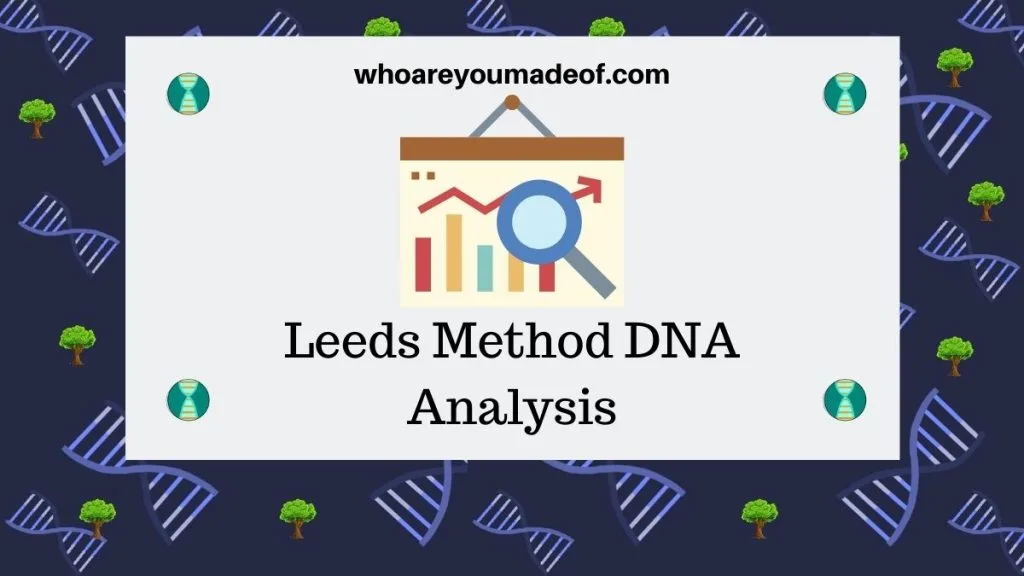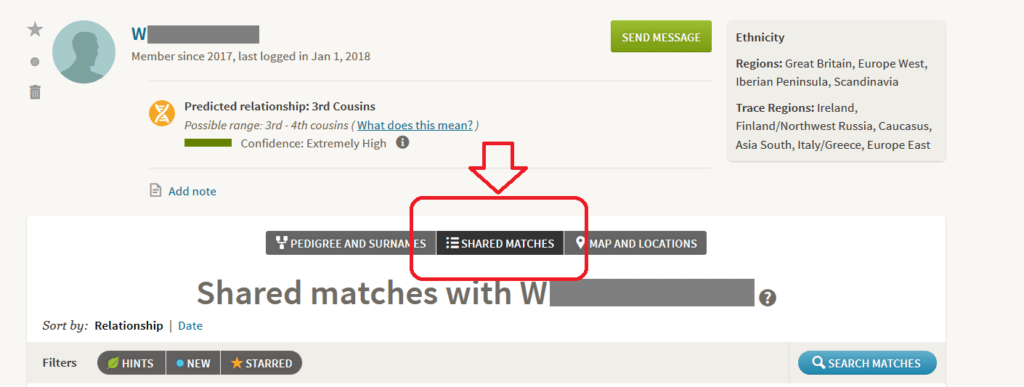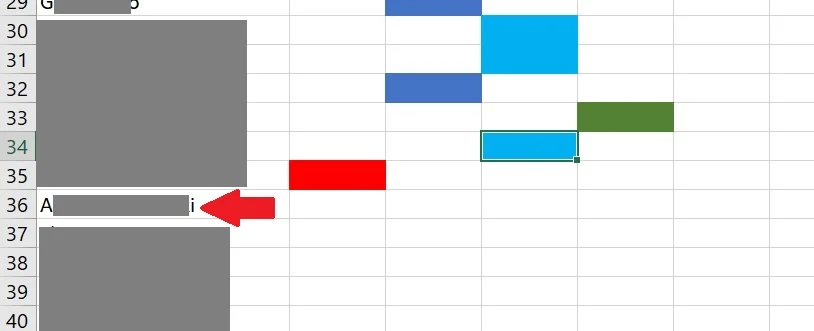Do you want to learn more about the Leeds Method DNA analysis? In this post, learn exactly how to use this method to organize your fourth cousin DNA matches.
You will also find out:
- What the Leeds Method in DNA actually is
- The benefits of using this strategy to cluster your DNA matches
- How you can use this method to determine how your DNA matches might be related

My list of fourth cousin DNA matches on Ancestry seems to grow every day. In fact, I know it grows most days.
Both of my parents have also tested their DNA with Ancestry, and that means that they have 4th cousin DNA matches, too!
Even though I think about my DNA match lists every day, I know that I am not getting as much from them as I could. This is where the Leeds Method comes in.
It's time to get a handle on the fourth cousin DNA matches using the Leeds Method!
What is the Leeds Method in DNA?
You can read my basic introductory post to the Leeds Method to learn about simple applications for this method and see an easy-to-understand example: What is the Leeds Method?
The example used in this post, using my mother's fourth cousin DNA matches, will be a more advanced used of the method.
Example of how to use the Leeds Method with 4th Cousin DNA matches
It is possible to use the Leeds Method with fourth cousin matches. I would recommend including second and third cousins, as well, however, since these are matches that we are likely to know the most about.
The real reason that I want to organize my mother's fourth cousin DNA matches is because I want to identify her Polish great-grandmother's origins. I've spent years researching her, yet I can't seem to make very much progress via genealogy records or DNA matches.
In other words, it's time to get a little bit more organized in my approach.
For this application of the Leeds Method, my goal is to identify groups of matches who I think might be descended from my mother's Polish great-grandmother's ancestors. Once I have a group identified, I can compare their ancestors to hopefully learn more about where she came from.
When you are researching unknown ancestors, any little detail can help.
For this project, you will need access to a spreadsheet. I use Microsoft Excel, but you can also use a free solution like Google Sheets.
Once you have opened your spreadsheet document up, you can follow along with the steps below to organize your cousins, including your fourth cousin matches, into colored clusters.
Step One: Make a list in your spreadsheet of your second, third, and fourth cousins
The first step in using the Leeds Method is to make a list in your spreadsheet of your DNA matches. Starting with the first second cousin match on your list and working down, just add each name to a new row in your spreadsheet, like this:
Most of us have a lot of fourth cousin DNA matches. For example, my mother has 426 fourth cousins who match her at a fourth cousin level or closer.
Since I am doing this exercise with the goal of searching family tree information, I will only include those fourth cousins with a public family tree attached to their Ancestry account. Including every fourth cousin will be too many, and eliminating those without family trees on their profiles will make sure my results are useful to me.
You can easily filter out fourth cousins who don't have family trees. Check out this post to learn how to do it: How to Filter and Sort Ancestry DNA Matches.
The list I did for this post included my mother's top 100 DNA matches who had family trees. The 100th DNA match shared one DNA segment of about 23 centimorgans in length.
Step Two: Assign all four of your grandparents a unique color
You should choose a unique color to assign to each of your grandparents. This is the fastest step in the process, as you can choose any color you wish.
It took about a minute to make the decisions and assign the colors.
I made a "color code" at the top of my spreadsheet so that way I didn't get confused and forget which color belonged to each of my mother's grandparents.
An advanced version of this process might allow you to assign a color to each of your great-grandparents. While this can help you learn more about more distant lines, it is also more difficult.
For beginners, this clustering technique is easiest to use sorting matches between your four grandparents.
Step Three: Beginning with closest cousin, assign them and all shared DNA matches the color that corresponds with the color you chose for the grandparent
Choose your closest DNA match on your list and give them the color that matches the grandparent through whom you are related to your DNA match.
You are not indicating that your DNA match is descended from your grandparent. Instead, you are notating that you know that your grandparent likely shared ancestors with this DNA match, meaning that you might be related to this DNA match on your grandparent's lines of the family tree.
In addition, be sure to check your "Shared Matches" in order to assign each of the matches that you share in common the same color that you gave your DNA match. The assumption is that the shared matches and your DNA match are all related through the same ancestor.
You can find the shared matches by clicking on the tab from the DNA match profile, as shown in the image below:

This step is where the real work starts. Exactly how long it takes you to complete this step will depend on how much you already know about your family tree and how many of your fourth cousin matches you have already researched to determine your connection.
I have spent a considerable amount of time researching my mom's fourth cousin matches over the past few years, so I have a general idea as to how many - not all - of her fourth cousin matches are related. If you have only recently begun to explore your matches, it might take you longer to work through your list.
In the image below, you can see that I have assigned my mother's grandparents four colors. The first DNA match on my list matches my mother on her grandmother "Emma R's" lines, and she is red, so I gave this DNA match a red square.

The shared matches tab for my mom's DNA match "A...z" (the first match on the list above) indicated that the next two DNA matches are also related on that line of the family. For this reason, these matches are red, too.
In other words, those three DNA matches and my mom's grandmother "Emma R." share ancestors.
There are a few things you should know as you work through this step (and the next one):
- The shared matches will include people who do and do not have trees, so you if your original list only included people with trees, then you should only include the shared matches that also have trees
- If you didn't filter your initial list of DNA matches, then you should work with all shared matches for each cousin
- If you don't know how you are related to someone, you can use "Common Ancestor Hints" and shared matches to make an educated guess
- For best results, you might want to read this post to help you figure out how you are related to each cousin you work with: How is your match related: Here's a checklist.
Step Four: Work down your list, cousin by cousin, repeating the process in Step Three
In this step, you will simply begin working down your list choosing the next cousin who does not already have a color assigned to them.
For example, in the image below you can see that DNA matches 29-34 already have colors assigned to their rows. Number 36, DNA match "A...i" does not have a color on his row, so this is my next match to work with:

Eventually, once I am finished with this process, I should have most - or all - of my mother's DNA matches assigned a color. In other words, they will be sorted into four categories belonging to all four of my mother's grandparents.
If you are choosing to work with more distant fourth cousin matches - a list more extensive than the "top 100" matches I chose from my mother's list, you might find that you have fourth cousins matches who don't have any shared matches in common with you.
It is normal to not have shared matches with distant relatives.
Step Five: Interpret your Leeds Method results
Once I am finished sorting all of my mom's DNA matches, I can begin the process of interpreting the results of the Leeds Method analysis. While there is a lot I don't know about some of my mother's ancestors, I am specifically interested in her Polish grandfather's ancestors.
Her Polish grandfather, "Peter P.", was assigned the dark blue on the spreadsheet. If I go through the spreadsheet and only look for DNA matches who have dark blue squares on their row, I will be able to identify DNA matches who are likely related to my mom through his mother or father's lines.
I am especially interested in Peter P.'s mother, so my next step would be to try to figure out which DNA matches are likely related to his mother and which are through his father. Then, I will research the family trees of those matches that I identify to be from Peter's mother's side of the family and research their family trees to find commonalities.
Conclusion
I hope that this post has helped you understand more about the Leeds Method for DNA analysis, and how you can use this DNA match clustering technique to organize your fourth cousin DNA matches.
If you have any questions about something that you read in this post, or if you tried out the Leeds Method and want to share tips, please join us in the discussion below.
Thanks for stopping by!

